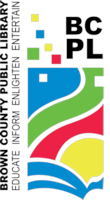HISTORY OF THE BROWN COUNTY PUBLIC LIBRARY
(Adapted from a manuscript composed by Harold Showalter)
The Brown County Public Library is a county library district approved in 1995 by the State Library Board at the formal request of the Board of Trustees of the Mary P. Shelton Public Library in Georgetown, Ohio. The formation of the new library district was for the express purpose of extending library services to the northern and central areas of Brown County as requested by the Mt. Orab Library Committee. The Brown County Public Library (BCPL) is an outgrowth of the proud history of the Georgetown Research Club and the Mary P. Shelton Public Library.The Georgetown library began in 1912, and was run by a volunteer organization called the Research Group. The library collection, composed of donations from local citizens and a “Traveling Collection”
from the State Library of Ohio, was housed in the Brown and Dunn Pharmacy. In 1913 the town gave the Research Group a room in the Georgetown Public Building for the growing collection and patronage. Inspired by the growing institution, a local citizen, Mary A. Cochran, established a trust fund in honor of her deceased granddaughter, Mary Powers Shelton, for the explicit purpose of constructing a building specifically for a public library to serve the community. By 1923 this vision came to fruition with the construction of the Mary P. Shelton Public Library in Georgetown, Ohio; later to become part of the Brown County Public Library.
1923 – The Mary P. Shelton Public Library is opened as a school district public library, freely serving
residents within the immediate school district boundaries and for a small fee for residents
outside the school district.
1934 – Through federal legislation which established a fund for public libraries, the Mary P. Shelton
Public Library began serving all Brown County residents free of charge.
1938 – The Mary P. Shelton Public Library became a member of the Ohio Library Association and the
American Library Association, establishing more professional standards.
1958 – Bookmobile service was established to accommodate underserved residents of the county.
1963 – Mt. Orab citizens began exploring the establishment of a public library.
1972 – The children’s library in the lower level of the Mary P. Shelton Public Library was opened.
1982 – Mary P. Shelton Public Library took measures to establish county library district status.
1988 – Expansion and renovations are completed on the Mary P. Shelton Public Library.
1995 – The State Library Board of Ohio granted county library district status to the Mary P. Shelton
Public Library, allowing for the establishment of branches within a specified district.
1996 - Voters established a bond issue for funding of additional branches.1996 – W. Scott and Jean Liming donated land for the site of the Mt. Orab branch; additional lots were
purchased for future expansion.
1996 – Land was purchased from Earl and Garnett Rapp - at a cost reflecting a significant donation to the
Library - for the site of the Fayetteville-Perry branch.
1997 - Brown County Public Library Foundation was established. The card catalog was converted to a
computerized catalog.
1998 – The Mt. Orab Library opened to the public. Land purchased from the Village of Sardinia for the
site of the Sardinia branch.
1999 – The Sardinia and Fayetteville-Perry Libraries opened to the public.
2001 – Grant funding was received from the Bill and Melinda Gates Foundation, doubling the number of
computers available for public use.
2009 – Voters passed a county-wide operating levy to support public library services.
2014 – Voters renewed the county-wide library levy with a 67.4% approval rate.
2018 – Voters passed a continuing 1-mill levy for public library services, receiving 53% affirmative votes. The passage assures stable funding at the local level. Collection of proceeds begins in 2020.
2020 – In March, the COVID-19 pandemic shuts down public libraries in Ohio for several months. When re-opened, new service protocols included curbside delivery, “quarantining” and disinfection of materials, and temperature checks and masks.
2021 – Pandemic relief funding trickled down to libraries, enabling upgrades to contactless book drops, and the installation of self-service lockers. In-person services were fully-restored. In late August, the Georgetown Library experienced a water pipe break that decimated the lower level of the building.
2022 – Sardinia and Fayetteville branches both dodged damage from tornadoes. The restoration of the lower level of the Georgetown branch is still in progress.
